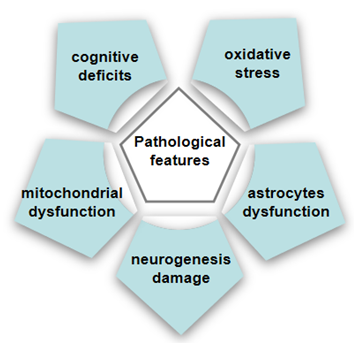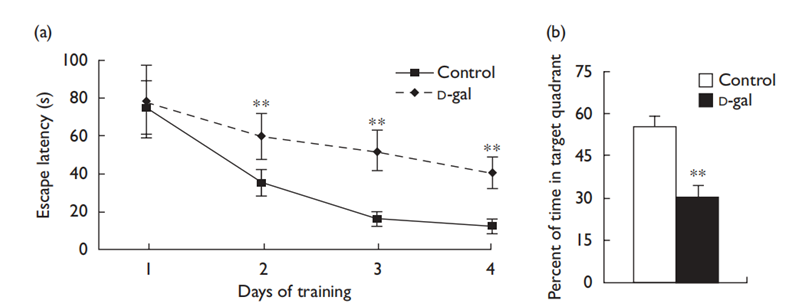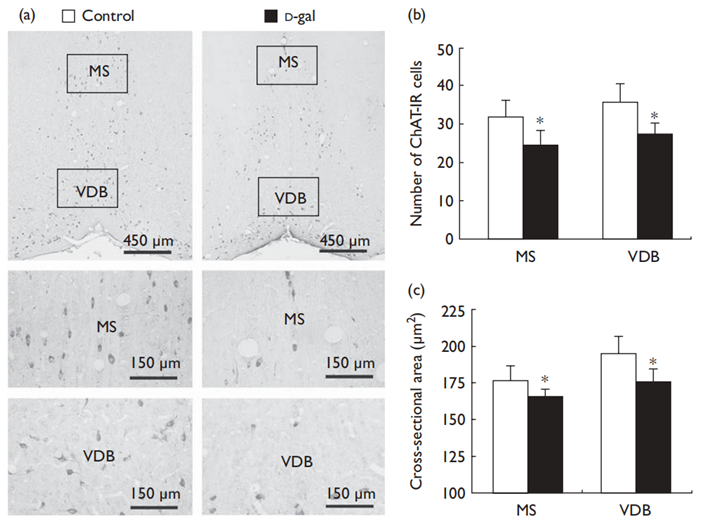D-gal Induced Model
D-galactose (D-gal), a sugar that exists in the mammalian body, can be converted into glucose by the catalysis of galactose-1-phosphate uridyltransferase and galactokinase. When rising to a abnormally high level, D-gal substantially induces the production of reactive oxygen species through galactose oxidation. In rats, or mice, after receiving a daily injection for 6-12 weeks of 50–200 mg/kg D-gal cognitive deficits, mitochondrial dysfunction and brain oxidative stress will be observed. In addition, chronic injection of D-gal also impairs neurogenesis and induces astrocytes dysfunction in the brain.
Creative Bioarray specializes in providing customized pharmacodynamic research services to help customers assess the efficacy of drug candidates and study the associated pathological mechanisms of brain ageing through D-gal induced model.
 Figure.1 Pathological features of D-gal induced model
Figure.1 Pathological features of D-gal induced model
Our Capabilities
- We can offer D-gal induced model to screen drugs for treatment of Alzheimer's disease.
- We can provide comprehensive behavioral and cognitive testing on AD model and the drug screening.
- We can utilize LTP (long-term potentiation) assay to evaluate your preclinical drug candidates against the synaptic impairments in animals.
- We can evaluate anti-oxidative stress in the brain of animals treated with drug candidates.
- We can evaluate various biomarkers through WB, IHC, ELISA, sequencing, etc.
Assays available
- Learning and memory deficits tests
- Synaptic impairment
- Oxidative stress
- Neuroinflammation
- Glycogen synthase kinase-3 beta (GSK3β)
- Neuronal loss
- β-AP level
- Plaque load
- Enzyme activity related to cholinergic system
- NMDA receptor function and excitotoxicity
- Mitochondrial dysfunction
- Brain slice staining and synaptic electrophysiology
With extensive experience in the field of AD, we are confident to help you to overcome any upcoming challenges. Our experts are fully capable of customizing our protocols and assays to meet your specific needs. With our help, we wish to facilitate your research with high efficiency.
Study examples
 Figure. 2 D-galactose (D-gal)-injected rats showed impairments of behavioral performance. (a) Comparison of latencies to platform during 4 training days in water maze test. (b) Percentage of time spent in the target quadrant in the probe test. **P<01 vs control group. Data represent mean±stand deviation from 10 rats per group.
Figure. 2 D-galactose (D-gal)-injected rats showed impairments of behavioral performance. (a) Comparison of latencies to platform during 4 training days in water maze test. (b) Percentage of time spent in the target quadrant in the probe test. **P<01 vs control group. Data represent mean±stand deviation from 10 rats per group.
 Fig. 3 ChAT immunohistochemistryin the rat forebrain 6 weeks after D-galactose (D-gal) injection. (a) Compared with controls (left panel), the density of ChAT immunoreactive neurons was decreased in the vertical limb of the diagonal band of Broca (VDB) and the medical septum (MS) in D-gal-injected rats (right panel). (b and c) Quantified data for mean number and soma size of ChAT immunoreactive neurons in the VDB and MS in the two groups. *P<0.05 vs. control group. Data represent mean±stand deviation from six rats per group.
Fig. 3 ChAT immunohistochemistryin the rat forebrain 6 weeks after D-galactose (D-gal) injection. (a) Compared with controls (left panel), the density of ChAT immunoreactive neurons was decreased in the vertical limb of the diagonal band of Broca (VDB) and the medical septum (MS) in D-gal-injected rats (right panel). (b and c) Quantified data for mean number and soma size of ChAT immunoreactive neurons in the VDB and MS in the two groups. *P<0.05 vs. control group. Data represent mean±stand deviation from six rats per group.
Quotation and ordering
If you have any special needs or questions regarding our services, please feel free to contact us. We look forward to cooperating with you in the future.
Reference
Lei M et al. Chronic systemic injection of D-galactose impairs the septohippocampal cholinergic system in rats. Neuroreport. 2008; 19: 1611-5.